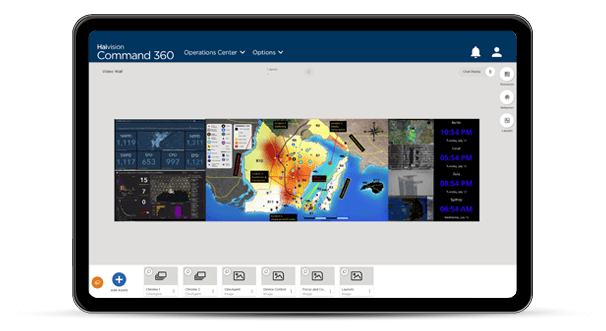Charlotte, NC is one of the fastest-growing cities in the US. Its population increased nearly 20% in the last decade, making it the 15th most populous city in the country. Rapid growth has its challenges – particularly for the CMPD and the Charlotte Fire Department (CFD), which are responsible for community safety. To address these challenges, the City of Charlotte decided to update the existing Public Safety Operations infrastructure to unify and streamline interdepartmental collaboration.
CMPD previously hosted a Command Center and Real Time Crime Center (RTCC) in their Police Headquarters along with an Emergency Operations Center (EOC) at a nearby location. These facilities were created to assist law enforcement during the 2012 Democratic National Convention. As the City of Charlotte prepared to host the 2020 Republican National Convention, they realized they needed to upgrade several critical visual collaboration systems across the three facilities. The upgrade needed to integrate with the city’s existing VMS system, dashboard tools, security applications, and other specialized tools.
The problems that hampered communication between departments and the original control rooms’ functionality all stemmed from legacy technology. The content management software that handled video wall inputs was cumbersome and difficult to navigate. Users couldn’t adjust content display layouts or customize video feeds without extensive back-end work. This led to increasingly longer prep times in control rooms designed for emergency monitoring and ‘as-needed’ operation. Inefficient setup during developing crises was obviously a hindrance to emergency workflows.
When the City of Charlotte began looking at new interdepartmental collaboration solutions, they sought to standardize technology throughout all three rooms with an intuitive, user-friendly platform. The system had to be easy to understand and operate by frequently rotating, sometimes non-technical teams using each room on the fly. After evaluating available options, the city chose Haivision and its proven history of delivering comprehensive, unified, video wall systems. The CineNet content control platform was especially appealing. It is designed for use by operators across all skill levels.
This is where municipal organizations reap the benefits of a genuinely collaborative visualization system. Any video technician, engineer, administrator, or standard user can navigate CineNet to quickly drag and drop video assets, arrange content, and create custom layouts saved at the click of a button. Now these rooms, designed for emergency response, can activate at the speed required to save lives and manage disasters.
Too often, control rooms created for public safety operations piecemeal technology year to year as they scale in size and responsibilities. What the update of the CMPD’s command center, RTCC, and EOC operations shows is the benefit of unifying visualization systems under a single technology umbrella. With all of the solutions operating on the same software and hardware platform, the city ensures more stable workflow and collaboration between departments, as well as secure communications across municipal agencies during times of need. As stated by Crystal Cody, the Public Safety Technology Director for the City of Charlotte, “By standardizing on a single technology platform, we are now able to successfully share video and content between systems and entities across disparate geographical locations with ease.”

